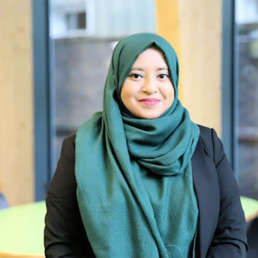
Written by Yamina Bibi
English Teacher and Assistant Headteacher
This is my speech from the virtual @DiverseEd conversation on 17th October 2020.
Whenever I want to go ‘out out’, I think about my outfit, which colour scarf will match the outfit and the perfect handbag that will enhance that outfit. The handbag might be a large or a small bag. It might have many compartments or just have the one for my phone and purse. My handbags change according to whatever it is I’ve decided to wear that day.
Sometimes, it feels to me like some organisations treat diversity and inclusion like it’s a handbag, picking and choosing the one that enhances their ‘outfit’ for that occasion. Do we just pick the protected characteristic that suits us or are we inclusive allies for every community that we say we represent? Are we committed to anti-discriminatory work in order to be the inclusive allies that we say we are? If so, how is this evident in every sphere of our organisation?
As a visibly muslim female leader, I have experienced workplaces where I have been one of a few Muslim women being represented at a middle and senior leadership level. I have known organisations where SLT are made up of male and or female white heterosexual leaders who claim to be inclusive allies but each time there’s a senior leadership role, it’s the same type of person that gets the job.
Can we truly call ourselves inclusive allies if our leadership teams do not reflect the staff and students we lead and represent? Can we be allies if we do not stand shoulder to shoulder with all marginalised groups and communities and actively ensure their voices are represented and heard? Can we call ourselves inclusive allies if we only stand and advocate for the rights of one community over the rights of other communities?
A few years ago I realised the importance of inclusive allyship in the workplace when I had wonderful white allies advocating for my voice to be heard as a visibly Muslim British woman. I noticed its power when I had colleagues from different communities such as LGTBQ+ community standing shoulder to shoulder with me and others from my community. I particularly noticed how important was for me that, when I spoke about the islamophobia I faced and the way I felt as a Brisih Muslim woman in the workplace, I was listened to and supported by white allies.
I also noticed the power of inclusive allyship when I stood and spoke to my students at an assembly for LGBT week alongside my colleague, Nick Bentley, about the power of intersectional and inclusive allyship. When a BAME student came to me to disclose that they identified as non-binary and they came to tell me because of an assembly I led on gender identity, I realised the power of representation and inclusive allyship.
We cannot underestimate the power of representation and the power of being allies because in so doing, students and staff are taught that who they are matters. They know that they bring their authentic selves to school and work and there is someone who will be recognise them and advocate for them regardless of whether they are from the same community or not.
I am very aware that my current workplace, where my Headteacher is a Muslim woman and where the Senior Leadership Team include BAME leaders, LGBTQ+ leaders and mothers, is different but it shouldn’t be. It should be the norm if we are truly dedicated to diversity and inclusion.
As a result of the diversity of my school, I am longer afraid to show up as my authentic self because I have allies who support me and advocate for me. I also look to actively and positively promote others from diverse backgrounds as a leader to ensure that diversity, inclusion and representation are not just words on our school walls or our School Development Plans but are lived by us all.
At my school, we are aware that there is still work to be done in ensuring that we are truly representative of our staff body. We must actively promote and be held accountable for our anti discriminatory work if we are to call ourselves allies.
So what can we do to ensure that allyship is not just another handbag we pick up when it matches our outfit?
- Schools should provide coaching for members of marginalised groups and communities to help them develop professionally and to ensure they have someone whose key role includes eliciting the brilliance from within them
- Actively partake in anti-discriminatory work and provide unconscious bias training for all staff regularly so we can recognise our own biases and challenge ourselves and each other to check our biases Provide opportunities for people from under presented groups to be seen and heard through in all spaces
- Ensure the curriculum celebrates diversity and inclusion and is embedded in all we do. I am done with seeing curriculums where marginalised communities are always victims, enslaved or need rescuing by someone with privilege and power such as a white heterosexual man. While it is important to remember the hurt and horrors of past experiences, we need to also show our students and staff that diversity and inclusion is a part of any successful society. We must usualise this. We need to celebrate excellence within all communities and we need to scrutinise our curriculum and our organisational values and be held accountable for the narratives we are advocating through our curriculum.
- Organise assemblies and events where colleagues stand shoulder to shoulder to show that inclusive allyship is the way forward in creating a society where everyone is welcome, represented and encouraged to thrive.
Let’s stop picking up D&I like it’s a handbag and ensure it’s a staple item in every organisation by standing with all communities in our words but most importantly, in our actions!

